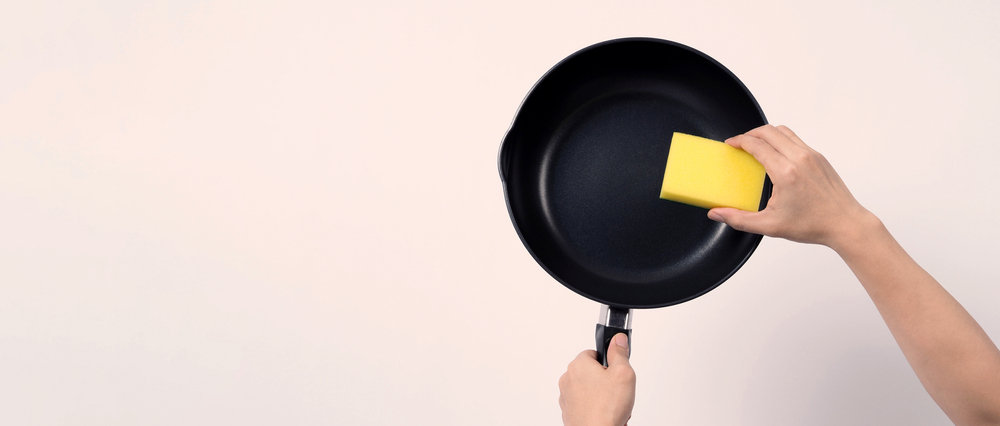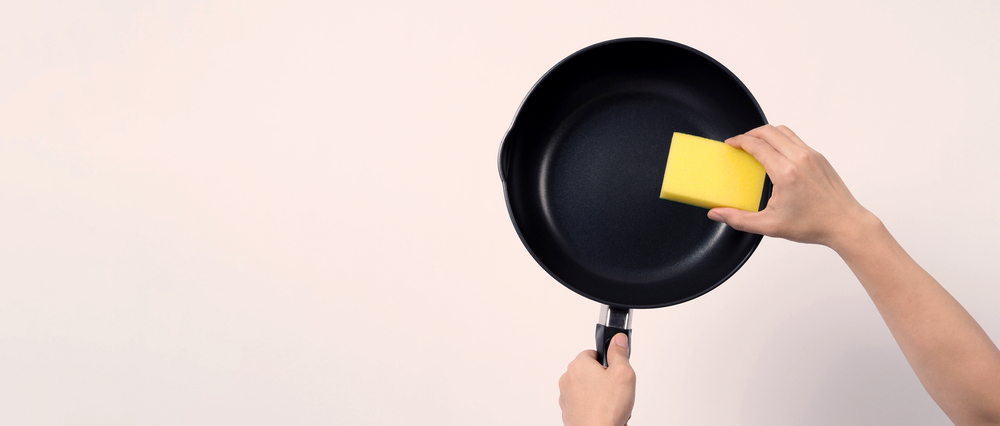Non-stick pans have been game-changers in the cooking world, allowing us to cook all types of cuisines without using a tonne of oil to keep the food from sticking and saving us mountains of cleaning time afterward.
However, there’s no play without work when it comes to non-stick pans as they need time and care when cleaning and looking after them to make sure they last.
If you think you’re one step ahead of the game and have been putting your non-stick pans in the dishwasher to save your time, then we’re sorry to tell you but it’s the wrong way to clean them.
Chances are if that’s your only way of cleaning them, you’ve noticed a drastic difference in the way your non-stick pans cook your food now and they’ve started to deteriorate.
If what is said above applies to you and you’re coming to terms with the loss of your trusty non-stick pans, then read on to mend the error of your ways and find out why they can't go in the dishwasher and how you REALLY should be washing and cleaning them.

What makes non-stick pans non-stick?
Non-stick cookware is coated with a material called polytetrafluoroethylene (PTFE) or is commonly known to all of us as Teflon.
It creates a frictionless surface which makes it perfect for cooking foods such as eggs, pancakes, and any common meal that would most likely stick to your regular pans.
Why shouldn't they go in the dishwasher?
Dishwashers are a savior to all mankind, they’ve saved us hours of scrubbing at the kitchen sink for decades now and are probably one of every household’s favorite appliances. However, your non-stick pans would disagree.
The dishwasher’s high water temperature and the strong cleaning detergent used to leave your cookware sparkling is damaging the Teflon coating off your non-stick pans.
This will lead to the coating thinning and will eventually start to peel away, either whilst in the dishwasher or when you’re cooking food in your pan. Once the non-stick coating has peeled away, you’ll find your food will start sticking easily to the pan whilst you cook and you’ll have to constantly keep stirring it or using excessive amounts of oil to keep it moving.
If your non-stick pan has managed to survive the harsh cycles of the dishwasher so far then do us a favor and switch to washing by hand before it’s too late, otherwise, you’ll be replacing it in no time and we know that a decent non-stick pan doesn’t go cheap nowadays.
Many high-quality brands claim that their non-stick cookware is dishwasher safe, however, the harsh washing detergent and high water temperature will eventually break down the non-stick coating, especially if you’re using it every day.
It’ll need to be replaced as the non-stick pans lose their purpose. This is where brands hope that you’ll repurchase another one of their non-stick cookware items again. We’re not saying it’s a marketing ploy, but it’s best to stay on the safe side and make your pots and pans last.
How should you clean non-stick pans?
So to keep your non-stick pans in tip-top condition, you’re going to have to wash them the old fashioned way, although, you need to make sure that you take care whilst washing them as handwashing can be very abrasive on the coating as well.
We recommend tackling your washing up of your non-stick pans straight away, but if you’re too hungry to wait until after your food, then sink your non-stick pan in warm soapy water until you’re ready to start washing up.
You’ll want to make sure that you’re using mild dish soap and nothing with any crazy chemicals in for the sake of your non-stick pan (and your skin!).
Use a microfiber cloth or a soft sponge to wash the inside and out of your pan. Avoid using rough metal scouring pads as they’ll scratch away the non-stick surface as well.
If you’ve got any tough grime left on your non-stick pan that won’t come off with good ol’ soap and water, then try sprinkling some baking soda over the area and mixing with a little bit of water until it becomes a paste and rub gently with your cloth.
Additionally, you could keep your dirty pan on the stove, fill it up with a few inches of water and pour some baking soda in, and let it simmer for ten minutes (or whilst you eat your food). You’ll want to do a final rinse with soapy water afterward to ensure all the baking soda is removed.
Make sure you gently dry your non-stick pans with a soft cloth or paper towels before putting them away, if you leave them to dry on their own on the rack it’ll encourage rusting which will then ruin the non-stick surface.
To avoid spending too much time washing your non-stick pans, you should make sure to use a little bit of oil or butter and cook on medium heat at highest. That’ll stop any food sticking and burning to the pan and will save you a lot of time afterward.
When is it time for a new one?
If you’ve witnessed the non-stick coating peeling away and cooking with your food then this would be a major sign to buy a new pan.
Once your food starts sticking to the pan and you’re struggling to get it off when washing it up, you’ll want to consider buying a new one.
Most chefs and retailers recommend you replacing your non-stick cookware after 5 years, although, it will depend on how regularly you use them and how much care you take when cleaning them.
If you wanted a short and straight answer then no, non-stick pans should not go in the dishwasher. Save your cash and take the time to wash your pans with care in order to extend their lifespan.



